In today’s segment of ETimes BFFs (Big Filmy Families), we decode the Chopra clan and their immense contribution to the world of cinema.
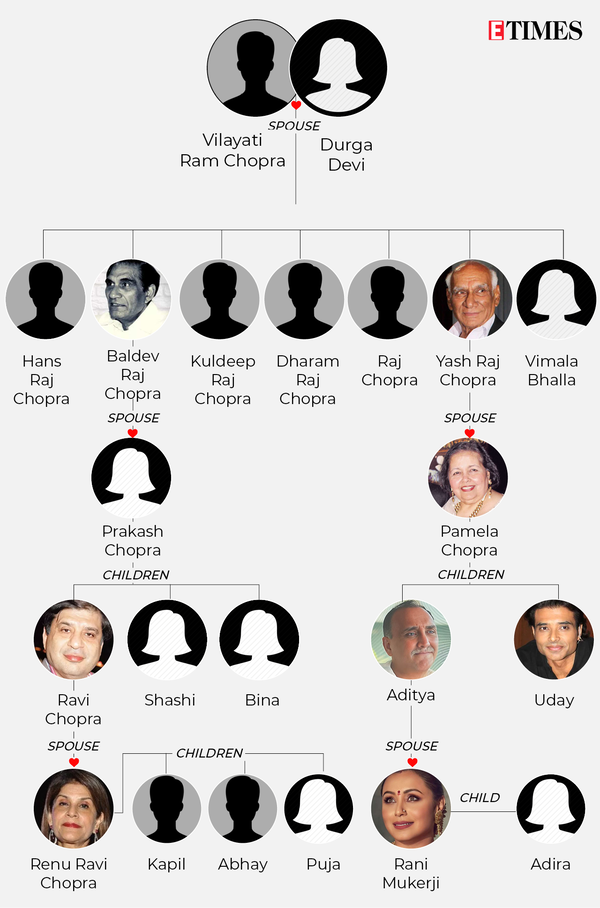
Vilayati Ram Chopra
Vilayati Ram Chopra was an accountant in the PWD division of the British Punjab administration. He was married to Durga Devi and they together had eight children – Hans Raj Chopra, Baldev Raj Chopra, Kuldeep Raj Chopra, Dharam Raj Chopra, Raj Chopra, Yash Raj Chopra, sister Vimala Bhalla.
Baldev Raj Chopra
BR Chopra, also known as Baldev Raj Chopra, stands as a luminary figure in the Indian cinema, yet his contributions often remain underappreciated. Despite his adeptness in filmmaking, evident through a string of successful films and shows under his direction and production, recognition eluded him. Among his notable achievements was the creation and production of the legendary television series, Mahabharat, helmed by his son Ravi Chopra.
BR Chopra’s illustrious career as a director is marked by numerous iconic films that not only showcased his talent but also provided opportunities for budding actors to shine. His repertoire includes memorable works such as Afsana, Naya Daur, Sadhna, Kanoon, Ek Hi Raasta, Gumrah, Hamraaz, Dhund, Nikaah, Pati Patni Aur Woh, and Insaf Ka Tarazu. As he transitioned into the role of a producer with his production house, BR Films, Chopra’s profound understanding of cinema proved instrumental in shaping his success in this new venture. He produced films like Baghbhan, Babul and Bhootnath, after 2000.
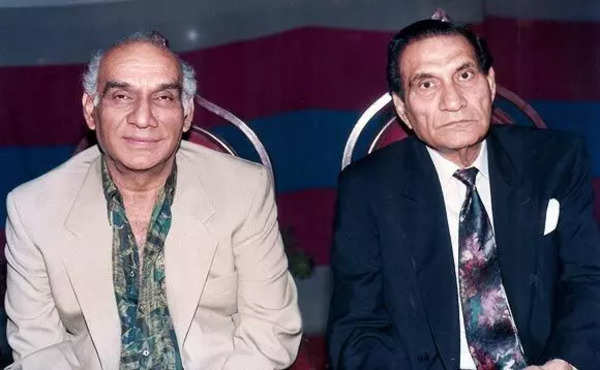
The senior Chopra was a trueblue reformist film-maker, way ahead of his times, who addressed issues while entertaining the multitudes.
His 1960 film ‘Kanoon’ starring Ashok Kumar-Rajendra Kumar was the first songless HIndi film. The film won a National Film Award for Best Feature Film in Hindi.
One of Indian cinema’s most influential films, Naya Daur addressed the impact of the industrial revolution on rural India.
It is noted that BR Chopra played a pivotal role in Yash Chopra’s journey toward realizing his cinematic aspirations. As Yash Chopra’s elder brother and mentor, BR Chopra not only comprehended Yash’s dreams but also provided crucial support and guidance to help him achieve those aspirations. Their bond and collaboration laid the foundation for Yash Chopra’s illustrious career in the Indian film industry.
Dharam Raj Chopra
Born on 24 August 1924, he was one of eight children including B R Chopra and Yash Chopra, born to Vilayati Raj Chopra, an accountant in the PWD division of the British Punjab administration. On graduating from Punjab University, he came to Bombay in 1948. He went on to join M and T Studios as an assistant in the camera department. He later joined his filmmaker brother B R Chopra and worked as operative cameraman for the film Sadhana (1958).
He made his solo debut as a full-fledged cinematographer in B R Chopra’s Dhool Ka Phool (1960). He is known for popular films such as Waqt (1965), The Burning Train (1980), Kanoon (1960), Ittefaq (1969), Pati Patni Aur Woh (1978), Insaf Ka Tarazu (1980), Nikaah (1982), and Amaanat (1977). He shot most of the films produced and directed by his brother BR Chopra. He won the Filmfare Award in the year 1965 for Best Cinematographer for Waqt. Later, his work in television saw him serve as director of photography for popular serials such as Mahabharat and Bahadur Shah Zafar.
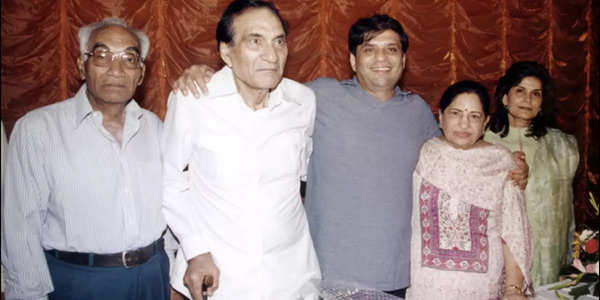
Dharam passed away on September 28, 2002, following a cardiac arrest. He was 78. He was survived by his wife and three daughters.
Hans Raj Chopra
Elder brother named Hans Raj Chopra. Hans Raj had a son named Lalit Chopra who has passed away. Lalit was married to Suman Chopra. Suman and Lalit Chopra have two daughters. Their names are Bhakti Mehta and Aradhna Bhandari.
Yash Chopra
Yash Raj Chopra was born on 27 September 1932 in Lahore, Punjab Province, British India, into a Punjabi Hindu Khatri family. He spent his formative years in Lahore, residing in the household of his elder brother Baldev Raj Chopra (BR Chopra), and attended college in Jalandhar. Despite initially aspiring to pursue a career in engineering, his deep-seated passion for filmmaking ultimately drew him to Mumbai.
Yash Chopra commenced his journey as an assistant to IS Johar and later to his brother, BR Chopra, before ascending to the director’s chair and helming five highly successful films under the BR Films banner. Each of these films marked significant milestones in his evolution as a top-tier director of blockbusters. Among them were ‘Dhool Ka Phool’ (1959), ‘Dharmputra’ (1961), ‘Waqt’ (1965) – recognized as India’s inaugural true multi-starrer generational family drama, ‘Ittefaq’ (1969), and ‘Aadmi Aur Insaan’ (1969). Additionally, he directed four other notable films produced by different companies: ‘Joshila’ (1973), ‘Deewaar’ (1975), ‘Trishul’ (1978), and ‘Parampara’ (1993).

But his greatest repertoire of work consisted of the 50 plus films made under the banner he launched – the banner that stands for the best of Hindi cinema – YRF. Out of these films, he directed 13 himself, and these films have defined much of the language of Hindi films as we know them today. Some of the highly successful films which Yash Chopra directed include ‘Daag’ (1973), ‘Kabhi Kabhie’ (1976), ‘Kaala Patthar’ (1979), ‘Silsila’ (1981), ‘Chandni’ (1989), ‘Darr’ (1993), ‘Dil To Pagal Hai’ (1997), ‘Veer-Zaara’ (2004), and ‘Jab Tak Hai Jaan’ (2012).
A fitting end to a glorious career, ‘Jab Tak Hai Jaan’, starring Shah Rukh Khan, Katrina Kaif, and Anushka Sharma, marked Yash Chopra’s final film as a director, wrapping up decades of fine work. He passed away on 21 October 2012 (at the age of 80), leaving behind a legacy that will inspire generations to come. The film was released on 13 November 2012 to an overwhelming response worldwide and emerged as one of the top grossers of the year.
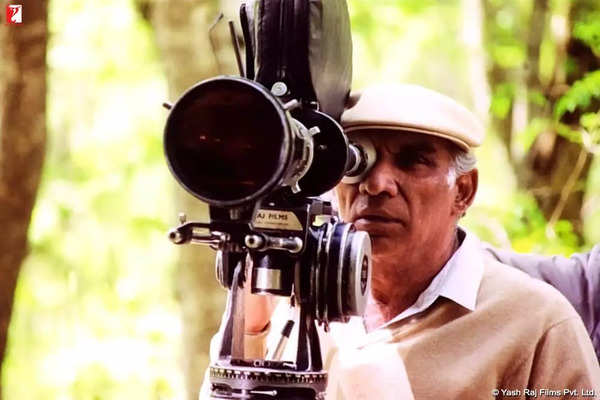
Yash Chopra played a pivotal role in defining the imagery of mainstream Hindi cinema worldwide. Dubbed as the ‘King of Romance’ due to his plethora of successful romantic films spanning five decades, he revolutionized the portrayal of drama and love on the silver screen.
Pamela Chopra
Pamela Singh, born in Amritsar on 19 February 1948, was the daughter of Mohinder Singh, an officer in the Indian Army. The eldest of three siblings, she had two younger brothers. Due to her father’s frequent postings across various remote locations in India, Chopra received her education at several army schools. She was a cousin of the actress Simi Garewal, as her father Mohinder Singh and Garewal’s mother Darshi Garewal were siblings.
Pamela Chopra entered into marriage with the filmmaker Yash Chopra in 1970, in a union arranged by their families in the traditional Indian fashion. The families were connected through a mutual friend, the mother of filmmaker Romesh Sharma, who suggested Pamela Singh as a suitable match for Yash Chopra, the younger brother of B.R. Chopra. Reflecting on their marriage four decades later, Pamela remarked in an interview, “She was not wrong because we had a wonderful marriage.” The couple’s first encounter was in a formal setting, where they found each other agreeable. Their wedding took place in 1970.
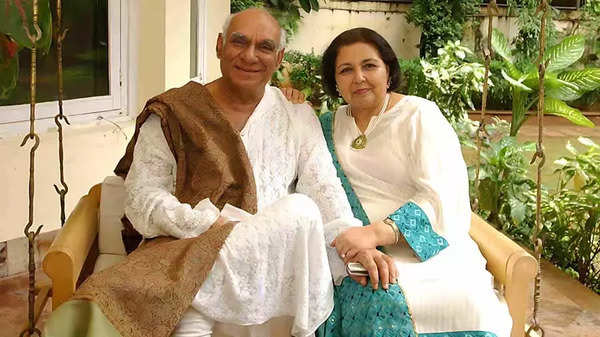
Pamela ventured into various aspects of the film industry. She showcased her singing talent in several film songs, such as ‘Kabhi Kabhie’ (1976) and ‘Mujhse Dosti Karoge!’ (2002). Additionally, she took on the role of a producer for certain films produced by her husband. Pamela also contributed as a co-writer for the script of her husband’s 1997 film ‘Dil To Pagal Hai,’ collaborating with Yash Chopra, her son Aditya Chopra, and professional writer Tanuja Chandra. While she made a brief on-screen appearance alongside her husband in the opening song ‘Ek Duje Ke Vaaste’ from the film ‘Dil To Pagal Hai,’ it marked her sole appearance on screen. As a schoolgirl, Pamela had learned Bharatanatyam, although she never performed publicly.
On 20 April 2023, Pamela Chopra passed away from pneumonia at Lilavati Hospital in Mumbai at the age of 75. She had been admitted to the hospital due to ‘age-related issues,’ and her condition rapidly deteriorated, ultimately leading to her being placed on a ventilator at the time of her death.
Simi Garewal
Few are aware that Simi Garewal and Yash Chopra’s wife, Pamela, are first cousins. Simi’s mother, Darshi, and Pamela’s father, Mohinder Singh, were siblings. Born on October 17, 1947, in Ludhiana, Simi grew up in England and studied at Newland house School with her sister Amrita.
Having spent a significant portion of her childhood in England, Garewal returned to India as a teenager. Her proficiency in the English language led the makers of the English-language film ‘Tarzan Goes to India’ to offer her a role. Garewal made her debut alongside Feroz Khan in this film, which was released in 1962. She worked with notable filmmakers like Mehboob Khan in Son of India (1962), Raj Khosla in Do Badan (1966), Raj Kapoor in Mera Naam Joker (1970), Satyajit Ray in Aranyer Din Ratri (1970, Days and Nights in the Forest) and Mrinal Sen in Padatik (1973, The Guerilla Fighter).
In the mid-1970s, Garewal appeared in the acclaimed film ‘Kabhi Kabhie’ (1976), directed by her brother-in-law Yash Chopra. She also had a leading role in ‘Chalte Chalte’ (1976). Another noteworthy performance was her portrayal as a vamp in ‘Karz’ (1980).
Garewal hosted the talk show Rendezvous with Simi Garewal.” Renowned for her distinct style, she often adorns her signature white attire during TV shows and at award ceremonies, earning her the moniker “The Lady in White.
Simi revealed in an interview with Mid-Day that she had accompanied Pamela to BR Chopra’s daughter’s wedding, where she ended up meeting Yash Chopra for the first time. The actor recalled that while Pamela thought he didn’t notice her, Simi saw him looking at her many times. After a few months, BR Chopra, Yash’s elder brother, asked Simi’s mother for Pamela’s hand in marriage. While Pamela’s father Mohinder Singh was reluctant at first, Simi’s mother assured them that all would be alright and she would take care of everything.
In the same interview, Simi spoke about how Pam contributed to Yash’s career. She added, “Initially, she would be there at the music sessions for Yashji’s films. Yashji would take a lot of inputs from her till the children (Aditya and Uday) came along. Yashji always remained a priority in Pam’s life. She was totally devoted to him.”
Ravi Chopra
Born on November 12, 1946, Ravi Chopra was the son of BR Chopra and Prakash Chopra. Ravi embarked on his professional journey by assisting his father, BR Chopra, in notable films such as Dastaan (1972) and Dhund (1973). Additionally, he lent his expertise to his uncle Yash Chopra in the making of Ittefaq (1969).
Taking a significant step forward, Ravi Chopra marked his independent directorial debut with Zameer in 1975. Notably, he collaborated with his father on the acclaimed television series Mahabharat (1988–89), showcasing their combined talent to a vast audience.
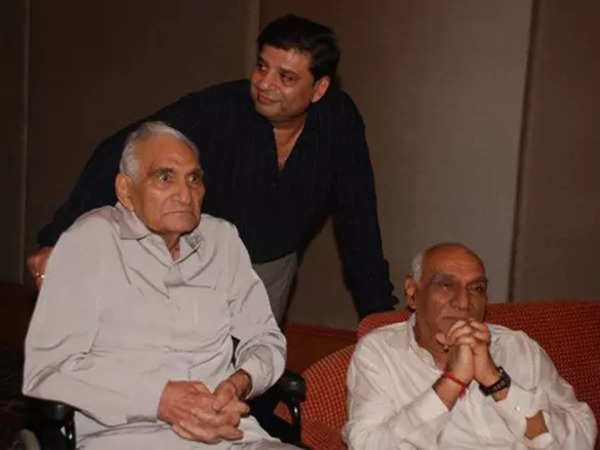
He got to married to Renu Chopra and they have three children together, Kapil Chopra, Abhay Chopra, Puja Talwar. Ravi Chopra passed away in 2014, leaving behind his wife and kids, while his contributions to cinema continue to be remembered.
Aditya Chopra
Aditya Chopra developed a deep passion for films from a young age. His early exposure to the world of cinema began with watching movies, but his education in filmmaking primarily took place within the realm of his father Yash Chopra’s home productions during his college and university years. At the age of 18, he embarked on his own journey in the film industry, starting as an assistant to his father in movies such as ‘Chandni’ (1989), ‘Lamhe’ (1991), and ‘Darr’ (1993). Despite achieving significant success in his own right, he remained steadfastly loyal to his father, providing support and assistance during the latter’s directorial ventures.
At the young age of 23, Aditya Chopra made his directorial debut with ‘Dilwale Dulhania Le Jayenge’ (DDLJ), a timeless classic that continues to grace theaters even after 26 years and over 1200 weeks since its initial release on 20 October 1995. His unique vision permeated every frame of the film, showcasing freshness, wit, romance, and undeniable chemistry between the lead pair. The seamless blend of modern sensibilities with traditional Indian values resonated deeply with audiences, making DDLJ an embodiment of Aditya Chopra’s creative prowess. He not only directed the film but also crafted its story, screenplay, and dialogue, earning accolades aplenty. DDLJ swept numerous awards, including 10 Filmfare Awards (the most for a film up to that point) and the prestigious National Award for Best Film, recognized for its contribution to popular and wholesome entertainment.
Aditya Chopra’s directorial ventures include ‘Mohabbatein’ (2000), a successful follow-up to his debut, and ‘Rab Ne Bana Di Jodi’ (2008), both top-grossing films in their respective years. ‘Mohabbatein’ notably celebrated Amitabh Bachchan’s career resurgence. His next film, ‘Befikre’ (2016), marked a departure into light-hearted romance, starring Ranveer Singh and Vaani Kapoor.
Aditya Chopra, a dedicated film enthusiast, ensures to watch a wide range of movies, including popular and entertaining ones, critically acclaimed films, and those that defy conventions.
On the personal front, Aditya Chopra’s first marriage to Payal Khanna ended in divorce in 2009, without any children from the union. Subsequently, in April 2014, he entered into matrimony with actress Rani Mukerji in an intimate ceremony held in Italy. Rani comes from the illustrious Mukerji family, renowned for their legacy of actors and filmmakers in the industry. Their union was blessed with the birth of their daughter, Adira Chopra, in December 2015, further enriching their familial bonds.
Rani Mukerji
Rani Mukerji was born on March 21, 1978 to Ram Mukherjee and Krishna Mukherjee. While her father was a former filmmaker, her mother is a former playback singer. Her brother Raja Mukherjee is a producer and director. Debashree Roy, her maternal aunt, is a renowned Bengali film actress. On her paternal side, she shares familial ties with Kajol, a prominent Hindi film actress and contemporary. Additionally, another paternal cousin, Ayan Mukerji, has made a mark in the industry as a scriptwriter and film director.
Rani Mukerji calls Indian movies the ‘best’ as filmmaker Prithvi Konanur opines Iranian cinema is far better; says ‘He should watch ’12th Fail’
Rani completed her studies in Mumbai and got trained in Odissi. Not many know that in 1994, director Salim Khan offered Mukerji the lead female role in his film ‘Aa Gale Lag Jaa.’ However, her father discouraged her from pursuing a full-time career in the film industry at such a young age, prompting her to decline the offer. When she turned 18, upon her mother’s suggestion to explore acting as an experimental pursuit, Mukerji decided to take on leading roles in two films: the social drama ‘Raja Ki Aayegi Baaraat,’ which was Khan’s second offer to her, and her father’s Bengali film ‘Biyer Phool.’ Remarkably, both movies were released on the same day in October 1996.
The actress, however, shot to fame with Karan Johar’s ‘Kuch Kuch Hota Hai’. Throughout her career, Rani has delivered several memorable performances across genres, including romantic dramas, comedies, and intense dramas. She is known for her ability to portray complex characters with depth and conviction. Some of her notable films include ‘Black’, ‘Mardaani’, ‘Bunty Aur Babli’, Hichki’, ‘Aiyyaa’, ‘No One Killed Jessica’, Mrs Chatterjee VS Norway’ and many others.
While Rani kept most part of her personal life away from the public and media glare, she made major headlines for her relationship with Aditya Chopra. The couple got married in an intimate Bengali ceremony in Italy on April 21, 2014. The following year, she gave birth to her daughter Adira.
Rani Mukerji’s trajectory in Bollywood is defined by her extraordinary talent, unwavering dedication to her craft, and a steadfast commitment to challenging societal norms through her portrayals and advocacy efforts. She remains a revered icon in the Indian film fraternity, captivating audiences with her stellar performances and making significant contributions both on and off the screen.
Uday Chopra
Uday Chopra, the younger son of the late Yash Chopra, began his film journey by assisting his father in movies such as ‘Lamhe’ (1991), ‘Parampara’ (1993), ‘Darr’ (1993), and ‘Dil To Pagal Hai’ (1997). Additionally, he provided assistance to his elder brother Aditya Chopra in his debut film, ‘Dilwale Dulhania Le Jayenge’ (1995), which emerged as one of the highest-grossing films of its release year.
Uday Chopra had a successful acting debut in ‘Mohabbatein’ (2000), directed by his elder brother, which emerged as one of the highest-grossing films of the year. Uday Chopra, portraying the character Ali, captivated audiences nationwide in ‘Dhoom’ (2004), a film that stood among the highest-grossing Hindi films of the year.
He also took on a leading role in ‘Neal ‘N’ Nikki’ (2005). Following the tremendous success of ‘Dhoom,’ its sequel, ‘Dhoom:2’ (2006), showcased another stellar performance by the youngest member of the Chopra family. Uday also portrayed the lead role in ‘Pyaar Impossible’ (2010), a film that he also wrote and produced for YRF. Additionally, he starred in ‘Dhoom:3’ alongside Aamir Khan in 2013.
In 2012, Chopra founded his own company, Yomics, which creates comics about famous Yash Raj Films including Hum Tum, Dhoom and Ek Tha Tiger.

